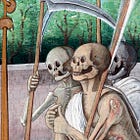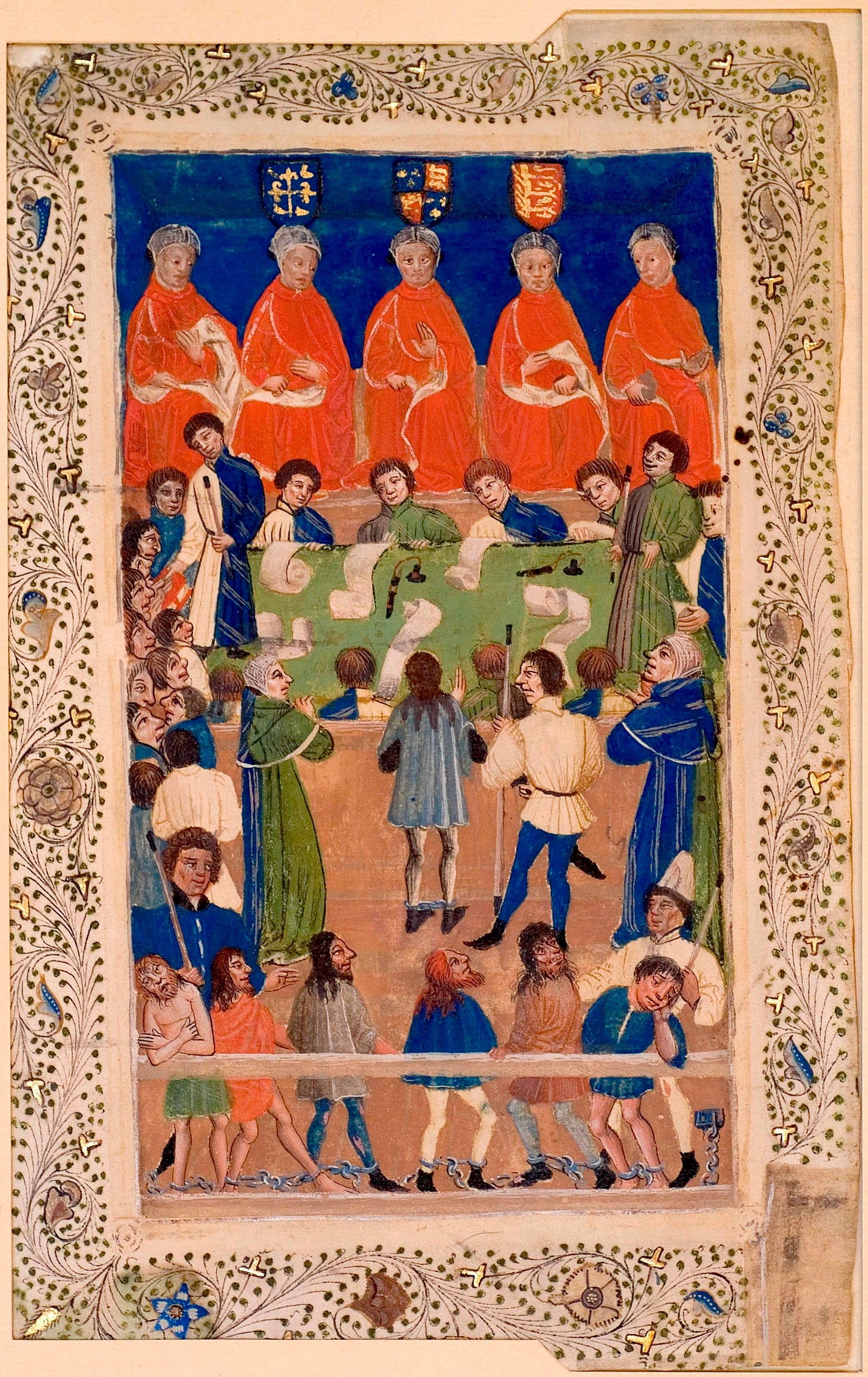Necromancy and the Law
I was researching legal history, digging through the enormous Selden Society compiled Year Books,1 when I chanced upon an index reference to necromancy.
This wasn’t any old case. The Year Book case report is huge. Here’s the facts:
In October 1371, John Crok was arrested one night. Crok’s case was bizarre, because in his bag was a dead man’s head. When questioned, he claimed that it was ‘the head of a Saracen’, purchased in Toledo, and he was planning ‘to shut a spirit up in it so the spirit would answer questions’. Classic necromancy! Given the court found no evidence our Crok had hurt anyone in the process (Saracen aside?)—and therefore not committed the sin of maleficium—he wasn’t punished personally.
The issue was with the perceived power vested in the head. Along with Crok, the head in the bag was possessed by John Typet, Bailiff for the Archbishop of Canterbury’s liberty of Southwark, who had been sent to collect it by his liege. The judges, via a letter sent to Typet from King Edward III, demanded the secular bailiff of Southwark collect the head as evidence in the trial.
William of Maldon, the bailiff of Southwark, came before the king at Westminster, and he is committed to the marshalsea [a different court, the High Court of Chivalry]. And John Tipet, the archbishop of Canterbury's bailiff, brought here into court the bag with the head and a book contained in the said bag. And John Crok is thereupon asked where he has got the head and for what purpose he has it in his keeping. And he says that the said head was the head of a Saracen and that he bought the head in Toledo, a certain city in Spain, in order to shut a spirit up in it so that the said spirit would answer questions, and that the book had to do only with experiments, and he had so far done nothing with the head. And because it is not found from the examination of John Crok or in any other way that he had done any deceit or evil to the king's people with the aforesaid head, the said John, laying his hand upon God's Holy Gospels, swore a corporal oath that he would henceforth not use it in this or any other way that is contrary to the faith of Holy Church. Therefore let him for the present go thence without day. And the marshal is told to burn the bag as well as the head and the book and also the other screws of paper with their various drawings etc.
Crok was picked up in Southwark in London, on the Thames’ south side. In the Middle Ages, when the City’s gates locked at night, vagrants and those who did not possess the Freedom of the City were left to their own devices there.
Before city walls fell out of fashion, they were ubiquitous. In the City of London (the Square Mile—not Westminster) this led to a stark divide. For example, Crossbones cemetery (below) was where sex workers, among those thrown out of the City at night, were buried in postmedieval Southwark. Works on the London Overground threatened to demolish the graveyard until a local charity were awarded a 30-year lease to preserve it.
Saracens’ heads were not an uncommon theme in London. There was a famous coaching inn and later pub, The Saracen’s Head, on Snow Hill in the City.
The pub was demolished in the late nineteenth century, after aeons of footfall. All that remains is its plaque.
Why ‘Saracens’?
Why all these poor Saracens’ heads? Well, without doing a full analysis in this mini-curio (I will one day), I think it’s just about combining striking imagery with classic exoticism in the post-Crusades world—or perhaps more specifically Orientalism. Toledo had a history on the frontier between the Islamic world and Christendom, too. It was common to depict one of the Three Kings from Biblical storytelling, usually called Balthasar, as a black man. This was not racially charged at this stage so much as charged by a similar feeling that spurred the ideas of wonder and marvelling (diversity, exoticism) I often write about.
And though London was not as much of a melting pot then as it is now, it was still a place ripe with people from all places and walks of life, including, for example, John Blanke—herald pursuivant to Henrys VII and VIII. That he was depicted without particular ceremony suggests that whilst unusual, London did have racial diversity.
Prophetic heads and magic also had a fascinating interplay—most famously popularised by Elizabethan playwrights in the “Brazen Head” myth, amplifying a rumour and ascribing it to medieval scholars like Roger Bacon and Albertus Magnus.
I do not own the images used in this post.
This is an archival post for Mini-Curio #11.
Specifically Select Cases in the Court of King’s Bench (vol IV 1965, ed GO Sayles), from page 153.












